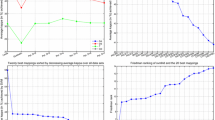Abstract
Dimensionality reduction (DR) approaches are often a crucial step in data analysis tasks, particularly for data visualization purposes. DR-based techniques are essentially designed to retain the inherent structure of high-dimensional data in a lower-dimensional space, leading to reduced computational complexity and improved pattern recognition accuracy. Specifically, Kernel Principal Component Analysis (KPCA) is a widely utilized dimensionality reduction technique due to its capability to effectively handle nonlinear data sets. It offers an easily interpretable formulation from both geometric and functional analysis perspectives. However, Kernel PCA relies on free hyperparameters, which are usually tuned in advance. The relationship between these hyperparameters and the structure of the embedded space remains undisclosed. This work presents preliminary steps to explore said relationship by jointly evaluating the data classification and representation abilities. To do so, an interactive visualization framework is introduced. This study highlights the importance of creating interactive interfaces that enable interpretable dimensionality reduction approaches for data visualization and analysis.





Similar content being viewed by others
Data availability
The datasets employed in these experiments are not only well-known but are also synthetic, ensuring easy reproducibility.
References
Basante-Villota C, Ortega-Castillo C, Peña-Unigarro D, Revelo-Fuelagán J, Salazar-Castro J, Peluffo-Ordóñez D. Comparative analysis between embedded-spaces-based and kernel-based approaches for interactive data representation. In: Advances in Computing: 13th Colombian Conference, CCC 2018, Cartagena, Colombia, September 2018;26–28, Proceedings 13. pp 28–38. Springer (2018)
Huang X, Wu L, Ye Y. A review on dimensionality reduction techniques. Int J Pattern Recognit Artif Intell. 2019;33(10):1950017.
Lee JA, Verleysen M. Quality assessment of dimensionality reduction: rank-based criteria. Neurocomputing. 2009;72(7):1431–43.
Lee JA, Peluffo-Ordóñez DH, Verleysen M. Multi-scale similarities in stochastic neighbour embedding: reducing dimensionality while preserving both local and global structure. Neurocomputing. 2015;169:246–61. https://doi.org/10.1016/j.neucom.2014.12.095. (linkinghub.elsevier.com/retrieve/pii/S0925231215003641).
Ortega-Bustamante MC, Hasperué W, Peluffo-Ordóñez DH, Paéz-Jaime M, Marrufo-Rodríguez I, Rosero-Montalvo P, Umaquinga-Criollo AC, Vélez-Falconi M. Introducing the concept of interaction model for interactive dimensionality reduction and data visualization. In: Lecture Notes in Computer Science (including subseries Lecture Notes in Artificial Intelligence and Lecture Notes in Bioinformatics) (2020). https://doi.org/10.1007/978-3-030-58802-1_14, https://link.springer.com/chapter/10.1007/978-3-030-58802-1_14
Ortega-Bustamante M, Hasperué W, Peluffo-Ordóñez DH, Imbaquingo D, Raki H, Aalaila Y, Elhamdi M, Guachi-Guachi L. Interactive information visualization models: a systematic literature review. In: International Conference on Computational Science and Its Applications. 2023;661–676. Springer
Pascual H, Yee XC. Least squares regression principal component analysis: a supervised dimensionality reduction method. Num Linear Algebra Appl. 2022;29(1): e2411.
Peluffo D, Lee J, Verleysen M. Generalized kernel framework for unsupervised spectral methods of dimensionality reduction (2014). https://doi.org/10.1109/CIDM.2014.7008664
Peluffo-Ordóñez DH, Alvarado-Pérez JC, Lee JA, Verleysen M et al. Geometrical homotopy for data visualization. In: ESANN (2015)
Peluffo-Ordóñez DH, Lee JA, Verleysen M. Recent methods for dimensionality reduction: a brief comparative analysis. In: European Symposium on Artificial Neural Networks (ESANN) (2014)
Peluffo-Ordóñez DH, Castro-Ospina AE, Alvarado-Pérez JC, Revelo-Fuelagán EJ. Multiple kernel learning for spectral dimensionality reduction. In: Pardo A, Kittler J, editors. Progress in pattern recognition, image analysis, computer vision, and applications. Cham: Springer International Publishing; 2015. p. 626–34.
Reddy GT, Reddy MPK, Lakshmanna K, Kaluri R, Rajput DS, Srivastava G, Baker T. Analysis of dimensionality reduction techniques on big data. IEEE Access. 2020;8:54776–88.
Suaboot J, Fahad A, Tari Z, Grundy J, Mahmood AN, Almalawi A, Zomaya AY, Drira K. A taxonomy of supervised learning for idss in Scada environments. ACM Comput Surv (CSUR). 2020;53(2):1–37.
Umaquinga-Criollo AC, Peluffo-Ordóñez DH, Rosero-Montalvo PD, Godoy-Trujillo PE, Benítez-Pereira H. Interactive visualization interfaces for big data analysis using combination of dimensionality reduction methods: a brief review. In: Basantes-Andrade A, Naranjo-Toro M, Zambrano Vizuete M, Botto-Tobar M, editors. Technology, sustainability and educational innovation (TSIE). Cham: Springer International Publishing; 2020. p. 193–203.
Valencia XPB, Becerra M, Ospina AC, Adarme MO, Melo DV, Ordóñez DP. Kernel-based framework for spectral dimensionality reduction and clustering formulation: a theoretical study. Adv Distrib Comput Artif Intell J. 2017;6(1):31–40.
Acknowledgements
Authors acknowledge the valuable support given by the SDAS Research Group (https://sdas-group.com/).
Author information
Authors and Affiliations
Corresponding author
Ethics declarations
Conflict of Interest
The authors declare that they have no conflict of interest.
Additional information
Publisher's Note
Springer Nature remains neutral with regard to jurisdictional claims in published maps and institutional affiliations.
This article is part of the topical collection “Emerging Technologies in Applied Informatics” guest edited by Hector Florez and Marcelo Leon.
Rights and permissions
Springer Nature or its licensor (e.g. a society or other partner) holds exclusive rights to this article under a publishing agreement with the author(s) or other rightsholder(s); author self-archiving of the accepted manuscript version of this article is solely governed by the terms of such publishing agreement and applicable law.
About this article
Cite this article
Aalaila, Y., Bachchar, I., Raki, H. et al. Joint Exploration of Kernel Functions Potential for Data Representation and Classification: A First Step Toward Interactive Interpretable Dimensionality Reduction. SN COMPUT. SCI. 5, 75 (2024). https://doi.org/10.1007/s42979-023-02405-9
Received:
Accepted:
Published:
DOI: https://doi.org/10.1007/s42979-023-02405-9




